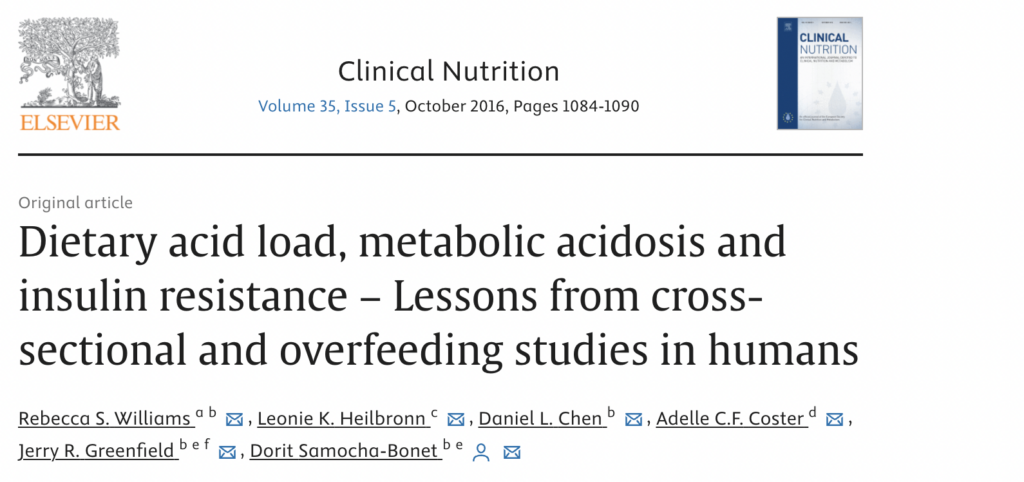Alkaline Diet & Type 2 Diabetes
Can an Alkaline Diet Reverse Type 2 Diabetes?
When I surveyed my newsletter subscriber list late last year, the first question I asked was “What are your top two health goals?”.
The top two overall (accounting for over 69% of the total votes)
- Losing weight and;
- Reversing insulin resistance/type 2 diabetes
This has to change.
The good news is…it is totally within our control. No matter how hard it seems, this is good news. Completely reversing weight gain and type 2 diabetes is 100% attainable through lifestyle and diet.
We spoke about the evidence of how an acidic diet significantly increases risk of gaining weight last week here. Today I want to talk about type 2 diabetes.
The Acidic Causes of Insulin Resistance
When an individual experiences high blood sugar—typically due to the consumption of an acidic diet of gluten, sugar, simple carbs, preservative, artificial sweeteners, and more—the pancreas responds by releasing insulin. Insulin is a crucial hormone tasked with regulating blood sugar levels, facilitating the entry of glucose into cells where it can be utilized for energy. However, the higher the blood sugar level, the more insulin must be released to manage it.
And it continues, because…
Consistently high blood sugar levels can lead to the chronic overproduction of insulin—a condition known as hyperinsulinemia. Over time, hyperinsulinemia can result in the rapid and extensive accumulation of visceral fat, particularly around the abdominal area. Visceral fat is bad news. It creates inflammation and oxidative stress which then further exacerbate insulin resistance. It’s a vicious cycle.
And then…
When the body is continuously exposed to high levels of insulin due to recurrent high blood sugar, it accelerates the storage of fat within the abdominal cavity, contributing to the growth of visceral fat deposits. This type of fat is linked to increased inflammation and is more harmful than subcutaneous fat.
And then…
As visceral fat accumulates, it impairs the body’s response to insulin, rendering cells less able to respond effectively to the hormone. This condition, known as insulin resistance, demands even higher levels of insulin to manage blood sugar levels, creating a vicious and self-perpetuating cycle of elevated insulin and insulin resistance.
This cycle of insulin resistance and hyperinsulinemia sets the stage for various metabolic complications, including type 2 diabetes, non-alcoholic fatty liver disease (NAFLD), cardiovascular disease, and polycystic ovary syndrome (PCOS).
Visceral fat releases pro-inflammatory cytokines and induces oxidative stress, further impairing insulin sensitivity and contributing to the development of chronic diseases associated with metabolic syndrome.
And it all comes from an acid-forming diet, and the resulting metabolic acidosis…
The mechanisms by which type-2 diabetes develops in the body are all related to the outcomes of an acidic diet, or what the literature calls “chronic diet-induced acidosis” (metabolic acidosis caused by diet).
Even just looking at a handful of the outcomes of an acidic diet, we can see how acidity has a multi-pronged attack that increases T2D risk significantly:
- Diet-Induced Acidity Leads to Increased Inflammation: acidic environment creates a ton of inflammation, a significant precursor to insulin resistance. This chronic inflammatory state is notable for the release of molecules that can disrupt the normal signaling pathways of insulin, diminishing its effectiveness in enabling cells to absorb glucose. Over time, persistent inflammation can induce a progressive dysfunction in the pancreatic β-cells responsible for insulin production and secretion. This disturbance in insulin production can be a contributing factor to the development of Type 2 Diabetes, as it compromises the body’s ability to regulate blood glucose levels effectively.
- Promotion of Endothelial Dysfunction:The acidity arising from a high dietary acid load can lead to endothelial dysfunction, a condition marked by the impaired function of the blood vessels’ inner lining. This dysfunction can reduce the availability of nitric oxide, a molecule crucial for maintaining blood vessel function, which then interferes with insulin regulation.
- Altered Insulin Sensitivity: Diet-induced acidosis also impairs the body’s responsiveness to insulin, meaning higher levels of insulin are needed to achieve the same glucose-lowering effect. This altered sensitivity places undue stress on the pancreatic β-cells, pushing them to work harder to meet the increased insulin demand. As this condition persists, it can lead to the exhaustion of the insulin-producing cells and result in reduced insulin secretion, ultimately culminating in the onset of Type 2 Diabetes.
- Creation of More Visceral Fat Cells: diet-induced acidosis leads to the increased formation of visceral fat cells, particularly around the abdominal region. Unlike subcutaneous fat, visceral fat is metabolically active and plays a role in releasing more pro-inflammatory cytokines and adipokines. These amplify insulin resistance and thus increase the risk of developing Type 2 Diabetes.
This is just four mechanisms. There are several more. They all show that the outcomes of eating an acidic diet dramatically increases the risk of developing insulin resistance and type-2 diabetes.
And it’s worth noting that the strain on the pancreas, and other areas of the endocrine system, the increase in inflammation (and we’ve not even mentioned the increased oxidative stress) are precursors to MANY other serious chronic conditions too.
What Do the Studies Say?

Unsurprisingly the data shows that when acidity in the diet increases, so does the risk of type 2 diabetes.
Study One: Positive association between dietary acid load and future insulin resistance risk
In this late 2020 study, published in Nutrition Journal, 5406 adults without type 2 diabetes, insulin resistance, cancer, or kidney diseases were studied over a 7.4 year period to see which participants developed insulin resistance.
They found that those who had higher levels of diet-induced acidosis were more likely to develop insulin resistance in the future compared to those with lower levels. The risk was significantly higher in participants with higher acid load scores, especially men below 50 years old.
Study Two: Dietary acid load, metabolic acidosis and insulin resistance – Lessons from cross-sectional and overfeeding studies in humans
This 2016 study published in Journal of Clinical Nutrition was incredibly interesting as it decoupled obesity as a primary influence in the impact of diet-induced acidosis and insulin resistance risk. In other studies it had been assumed that the impact of diet-induced acidosis was worse where the subjects were already overweight or obese. But this study was able to show the risk is the same regardless.
The study looked at 104 men and women in a cross-sectional analysis, wherein insulin sensitivity was gauged using a hyperinsulinemic-euglycemic clamp and plasma lactate levels were assessed as a marker for metabolic acidosis. Dietary acid load was determined through diet diaries, yielding PRAL (potential renal acic load) and NEAP (net endogenous acid production) scores.
They found, independent of obesity, that increased dietary acid load aligned with increased insulin resistance. The study concluded: “There is mounting evidence to suggest that a diet with high acid load increases body acidity and predicts insulin resistance and type 2 diabetes”
Study Three: The role of dietary acid load and mild metabolic acidosis in insulin resistance in humans
And in this final study published in 2023 in the European Review for Medical and Pharmacalogical Sciences, 204 participants were recruited, among which 92 were newly diagnosed with Type 2 diabetes, and 102 were healthy controls matched in terms of age and gender.
The dietary acid load was measured using PRAL, and NEAP, both determined from dietary recalls.
The findings of the study revealed a pronounced contrast in the dietary acid load mean scores between the case and control groups. Those in the highest category of PRAL and NEAP exhibited a significantly elevated risk of developing Type 2 diabetes compared to individuals in the lowest category, even after accounting for multiple potential influences.
In other words, regardless of what else was going on in the body, eating an acidic diet still significantly increased the risk of insulin resistance and type 2 diabetes.
The Answer Is Clear…Move to an Alkaline Forming Diet
And of course, this is where I can help!
You’ll have seen the depth of the free guides, resources and recipes available on this site already I’m sure.
But also this coming SUNDAY 1st OCTOBER, I am running a free, 3-part live training series called The Alkaline Weight Loss Blueprint. Each day, for 3 days in a row (Sun, Mon, Tue) I will go live with a tutorial and Q&A. All live, all free.
And if you register, you also get the recordings to keep 🙂
Here’s the link to register. I can’t wait to see you on the sessions!
References:
Giha, Hayder A. 2023. “Hidden Chronic Metabolic Acidosis of Diabetes Type 2 (CMAD): Clues, Causes and Consequences.” Reviews in Endocrine and Metabolic Disorders 24 (4): 735–50. https://doi.org/10.1007/s11154-023-09816-2.
Lee, Kyung Won, and Dayeon Shin. 2020. “Positive Association between Dietary Acid Load and Future Insulin Resistance Risk: Findings from the Korean Genome and Epidemiology Study.” Nutrition Journal 19 (1). https://doi.org/10.1186/s12937-020-00653-6.
Ozturk, E. E., and H. Yildiz. 2023. “Examining Dietary Acid Load in Individuals with Type 2 Diabetes: A Case-Control Study.” European Review for Medical and Pharmacological Sciences 27 (6): 2443–52. https://doi.org/10.26355/eurrev_202303_31778.
Williams, Rebecca S., Pinar Kozan, and Dorit Samocha-Bonet. 2016. “The Role of Dietary Acid Load and Mild Metabolic Acidosis in Insulin Resistance in Humans.” Biochimie 124 (May): 171–77. https://doi.org/10.1016/j.biochi.2015.09.012.
Williams, Rebecca S., Leonie K. Heilbronn, Daniel L. Chen, Adelle C.F. Coster, Jerry R. Greenfield, and Dorit Samocha-Bonet. 2016. “Dietary Acid Load, Metabolic Acidosis and Insulin Resistance – Lessons from Cross-Sectional and Overfeeding Studies in Humans.” Clinical Nutrition 35 (5): 1084–90. https://doi.org/10.1016/j.clnu.2015.08.002.







Ross – people have been eating acidic diets for a long time in our culture. So why the sudden rise in obesity, diabetes, etc?
It can’t just be food.
Think ubiquitous incessant wireless radiation from zillions of devices everywhere, including smartphones to babysit our toddlers.
I am glad to take in this study. My sugars are currently high, and a new med has not helped a bit. Seriously needing to get refocused with the Alkaline way, and yet I am having a hard time getting with the program. For several months now my body has been off sync. Tummy issues have improved, but the sugars continue to hold their own. Sigh.